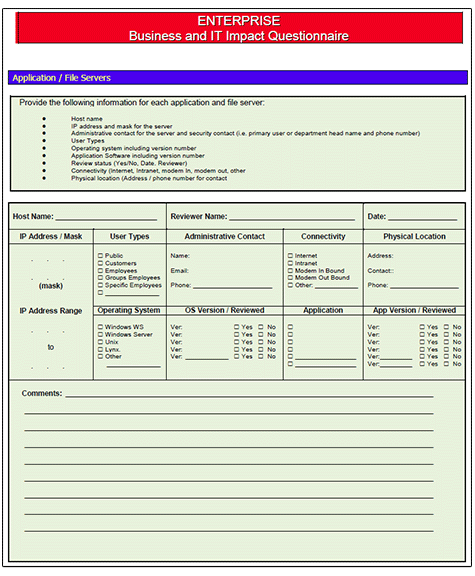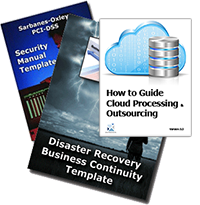Business Impact Analysis - BIA
Business and IT Impact Questionnaire is included with all of the Security, DR, BC, and Complaisance Offering or it can be acquired separately
Risk Assessment Methodology Compliant with ITIL Framework
 A business impact analysis (BIA) predicts the consequences of disruption of a business function and process. Its purpose is to collect information needed to develop recovery strategies.
A business impact analysis (BIA) predicts the consequences of disruption of a business function and process. Its purpose is to collect information needed to develop recovery strategies.
Potential loss scenarios are be identified during a risk assessment which is dependant on the BIA assessment. Operations can be interrupted by the failure of a supplier of goods or services or delayed deliveries. There are many possible scenarios that need to be assessed.
Differance between disaster recovery versus busiess continuity
Business continuity focuses on keeping the business operating. Where disaster recovery tends to deal with systems and data, business continuity is focused on overall business operations. Typically business continuity involves prioritizing various business processes and recovering the most important ones first. Thus, disaster recovery is focused getting the entire IT infrastructure back up while business continuity is more likely to work on getting the parts dealing with critical processes like transaction processing operational as soon as possible.
Business impact analysis supports business continuity by attempting to decide which processes are the most critical to recover in case of a disaster. This usually involves assigning monetary value to the protection of assets involved in specific business processes.
Order BIA Questionnaire Download Selected Pages
Sample BIA File Server Assessment Form
The Business and IT Impact Questionnaire is delivered electroncially in MS Word and PDF formats. Below is page one of two pages for the File Server assessment form.
BIA Risk Assessment Methodology
The typical organization has hundreds of applications all at different recoverability capability. For example some have no plan, some have out of region architectures some have not exercised in long time and some are in great shape testing every quarter.
All of the applications need to be categorizing them so that the Disaster Planning Team can start re-mediating the ones that place the enterprise at the most risk to the business from both a compliance and readiness perspective.
Using the ITIL framework, you can weigh each Critical Success Factor (CSF) and scoring their Key Performance Indicators (KPI). That allows you to create a rating system and developing a score card report by tiers.
Weighting Critical Success Factors
Examples
- 6 = Critical to success of recovery
- 3 = Required for timely recovery (could recover without but risk is increased)
- 1 = Needed to support recovery but only minimal impact on recovery efforts
Scoring of Key Performance Indicators
Examples
- Not in place or not implemented = 0
- Completed but past the KPI deadline, not accurate or incomplete = 1
- In place or completed on time = 3
- Final rating for each CSF and the associated KPI multiply the weight of the CSF by the score of the KPI
Critical Success Factors/Key Performance Indicators Examples:
- CSF: Conduct exercise at alternate facility (Weight 6)
- KPI = Conduct an annual exercise alternate facility
- CSF: Update BCP Plans (Weight 3)
- KPI = Update BCP plans by <insert date> each year
- CSF: Conduct Annual Tabletop of recovery Plan (Weight 3)
- KPI = Conduct at least 1 annual tabletop of BCP plans by December
Disaster Planning Template Contains the BIA Questionnaire
Order BIA Questionnaire Download Selected Pages
The Disaster Recovery Plan (DRP) includes the BIA Business Impact Analysis Questionnaire. In addition the Disaster Planning and Business Continuity Planning Template include:
- Disaster Recovery Plan and Business Continuity framework
- Work Plan
- Disaster Recovery and Business Continuity Audit Program
- Pandemic Planning Checklist
- Incident Communication Plan and Policy
- Electronic Forms
The Disaster Recovery - Business Continuity Template purchase options are










